Engineering Challenges of Katrina – A Case Study for Ethics Study
VerifiedAdded on 2023/01/17
|17
|3923
|1
Report
AI Summary
This report provides a comprehensive case study of the engineering challenges posed by Hurricane Katrina, focusing on the devastating impact on New Orleans. It examines the causes of the hurricane, the resulting damage to agricultural land and crops, and the formation of the ASCE panel to investigate the failures of the hurricane protection system. The report delves into the panel's recommendations, addressing engineering design, soil strength, and the need for system repairs. It also discusses the challenges faced and lessons learned from the disaster, emphasizing the importance of engineering ethics and the need to prioritize public safety. The analysis includes a brief overview of the hurricane's progression, from its initial landfall to the flooding of the city, highlighting the human and economic consequences and the role of the ASCE panel in evaluating the failures and providing recommendations for future disaster preparedness and response.
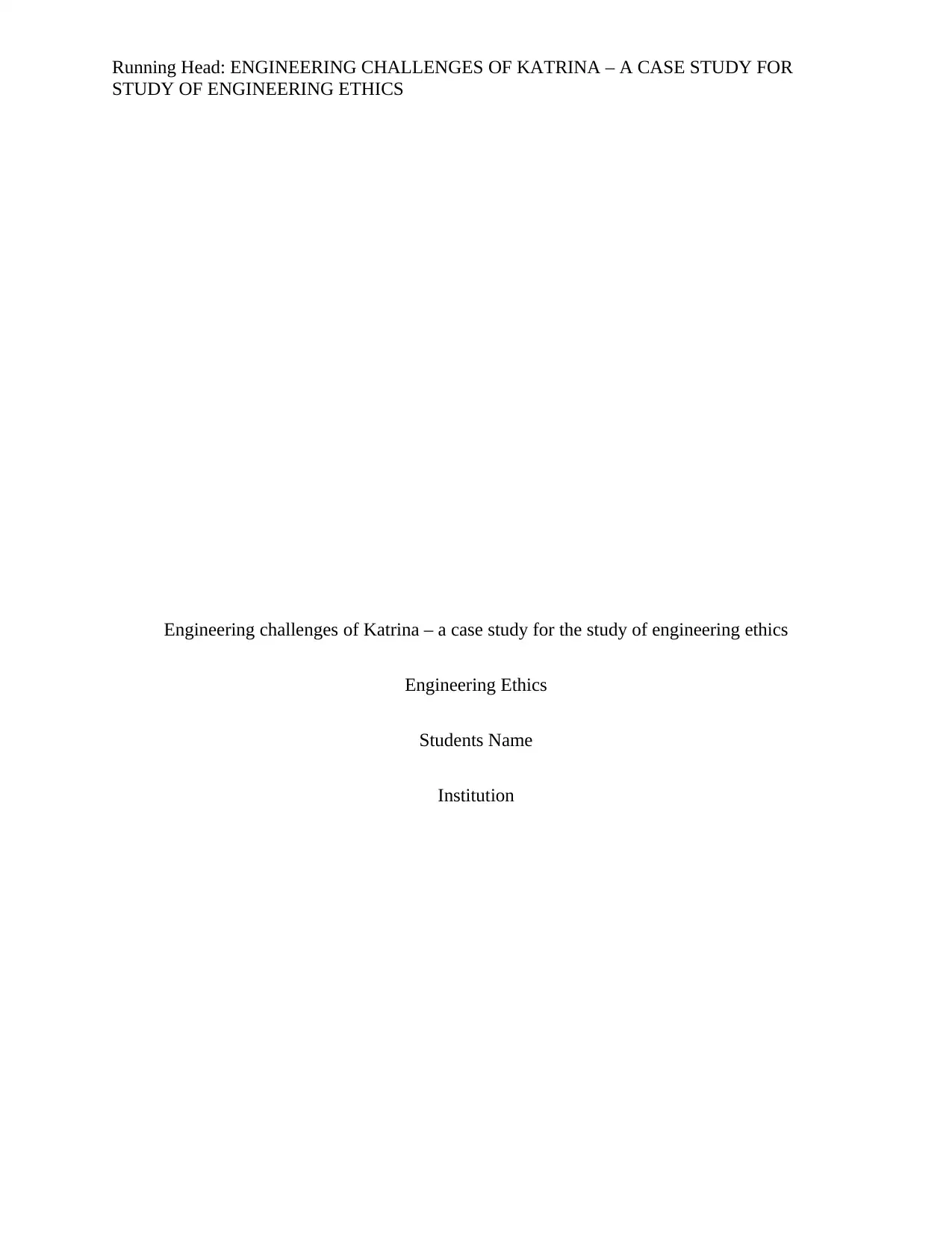
Running Head: ENGINEERING CHALLENGES OF KATRINA – A CASE STUDY FOR
STUDY OF ENGINEERING ETHICS
Engineering challenges of Katrina – a case study for the study of engineering ethics
Engineering Ethics
Students Name
Institution
STUDY OF ENGINEERING ETHICS
Engineering challenges of Katrina – a case study for the study of engineering ethics
Engineering Ethics
Students Name
Institution
Paraphrase This Document
Need a fresh take? Get an instant paraphrase of this document with our AI Paraphraser
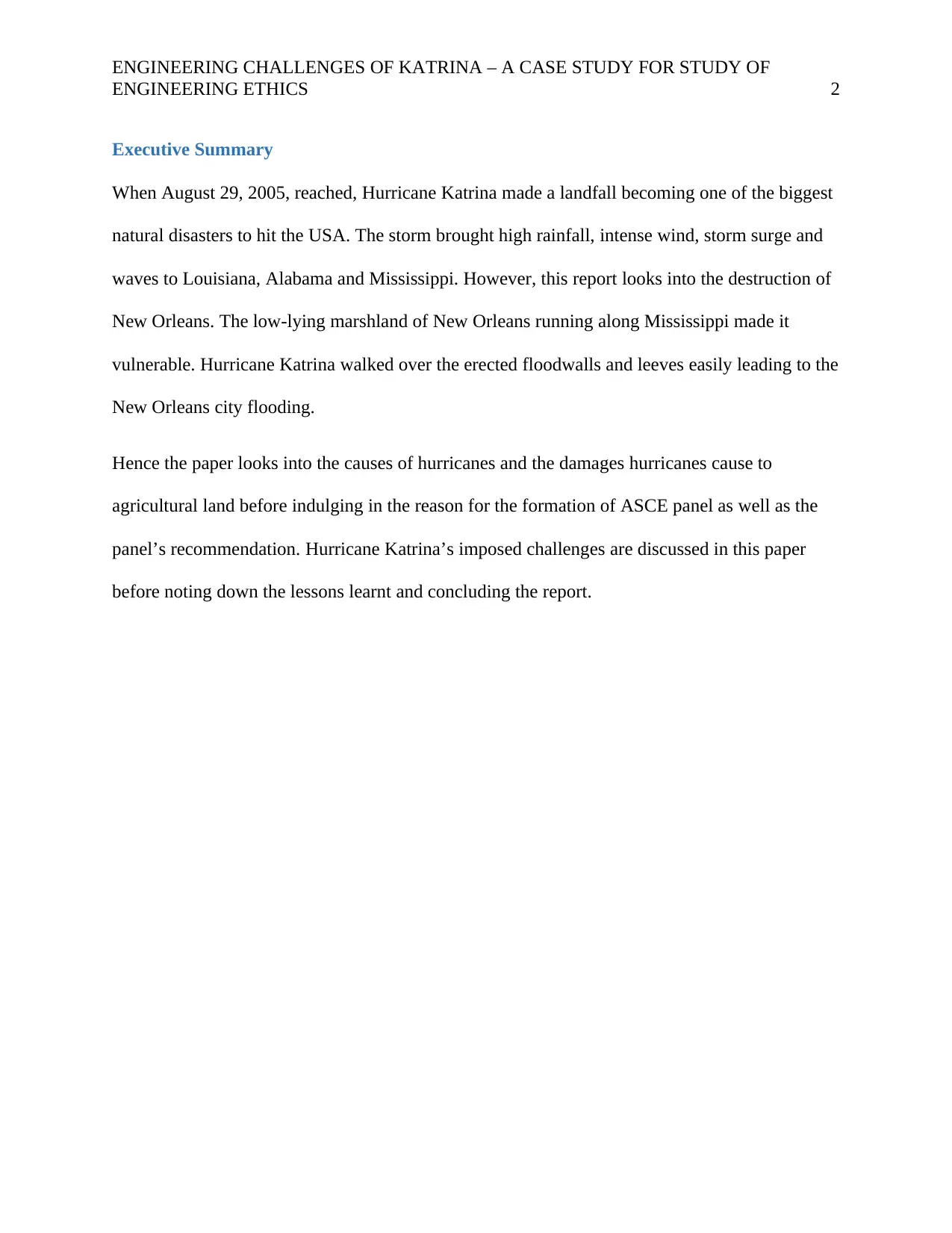
ENGINEERING CHALLENGES OF KATRINA – A CASE STUDY FOR STUDY OF
ENGINEERING ETHICS 2
Executive Summary
When August 29, 2005, reached, Hurricane Katrina made a landfall becoming one of the biggest
natural disasters to hit the USA. The storm brought high rainfall, intense wind, storm surge and
waves to Louisiana, Alabama and Mississippi. However, this report looks into the destruction of
New Orleans. The low-lying marshland of New Orleans running along Mississippi made it
vulnerable. Hurricane Katrina walked over the erected floodwalls and leeves easily leading to the
New Orleans city flooding.
Hence the paper looks into the causes of hurricanes and the damages hurricanes cause to
agricultural land before indulging in the reason for the formation of ASCE panel as well as the
panel’s recommendation. Hurricane Katrina’s imposed challenges are discussed in this paper
before noting down the lessons learnt and concluding the report.
ENGINEERING ETHICS 2
Executive Summary
When August 29, 2005, reached, Hurricane Katrina made a landfall becoming one of the biggest
natural disasters to hit the USA. The storm brought high rainfall, intense wind, storm surge and
waves to Louisiana, Alabama and Mississippi. However, this report looks into the destruction of
New Orleans. The low-lying marshland of New Orleans running along Mississippi made it
vulnerable. Hurricane Katrina walked over the erected floodwalls and leeves easily leading to the
New Orleans city flooding.
Hence the paper looks into the causes of hurricanes and the damages hurricanes cause to
agricultural land before indulging in the reason for the formation of ASCE panel as well as the
panel’s recommendation. Hurricane Katrina’s imposed challenges are discussed in this paper
before noting down the lessons learnt and concluding the report.
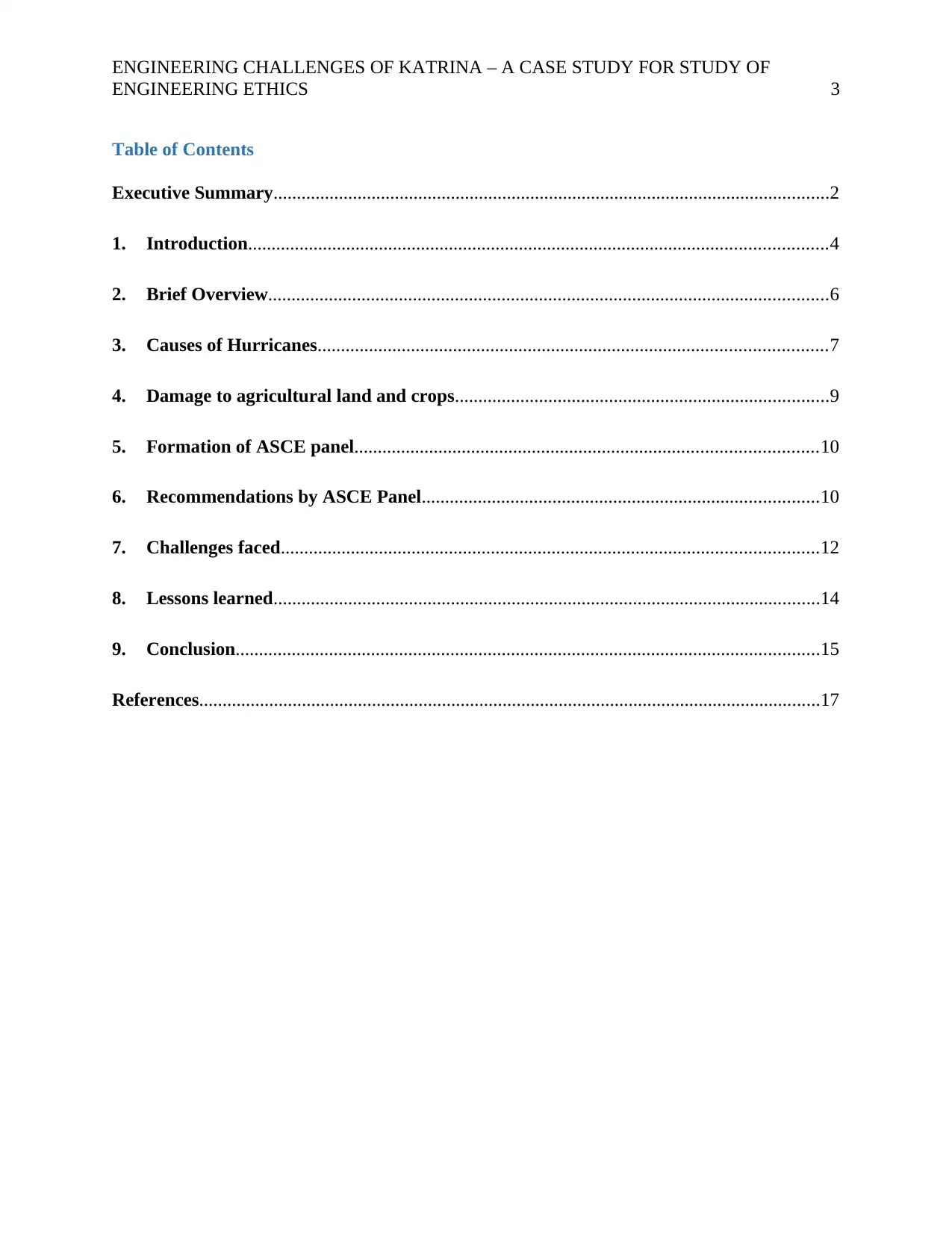
ENGINEERING CHALLENGES OF KATRINA – A CASE STUDY FOR STUDY OF
ENGINEERING ETHICS 3
Table of Contents
Executive Summary.......................................................................................................................2
1. Introduction............................................................................................................................4
2. Brief Overview........................................................................................................................6
3. Causes of Hurricanes.............................................................................................................7
4. Damage to agricultural land and crops................................................................................9
5. Formation of ASCE panel...................................................................................................10
6. Recommendations by ASCE Panel.....................................................................................10
7. Challenges faced...................................................................................................................12
8. Lessons learned.....................................................................................................................14
9. Conclusion.............................................................................................................................15
References.....................................................................................................................................17
ENGINEERING ETHICS 3
Table of Contents
Executive Summary.......................................................................................................................2
1. Introduction............................................................................................................................4
2. Brief Overview........................................................................................................................6
3. Causes of Hurricanes.............................................................................................................7
4. Damage to agricultural land and crops................................................................................9
5. Formation of ASCE panel...................................................................................................10
6. Recommendations by ASCE Panel.....................................................................................10
7. Challenges faced...................................................................................................................12
8. Lessons learned.....................................................................................................................14
9. Conclusion.............................................................................................................................15
References.....................................................................................................................................17
⊘ This is a preview!⊘
Do you want full access?
Subscribe today to unlock all pages.

Trusted by 1+ million students worldwide
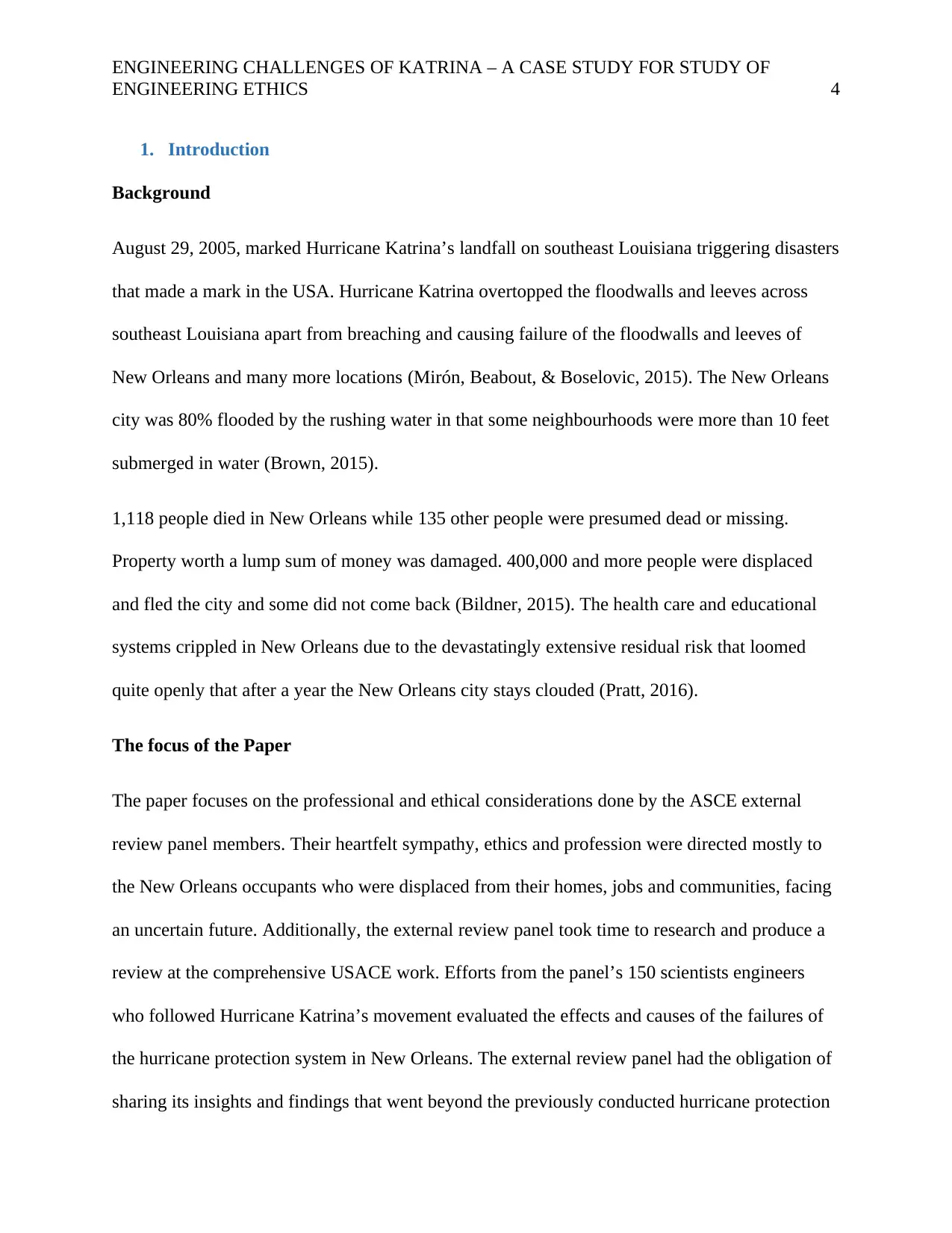
ENGINEERING CHALLENGES OF KATRINA – A CASE STUDY FOR STUDY OF
ENGINEERING ETHICS 4
1. Introduction
Background
August 29, 2005, marked Hurricane Katrina’s landfall on southeast Louisiana triggering disasters
that made a mark in the USA. Hurricane Katrina overtopped the floodwalls and leeves across
southeast Louisiana apart from breaching and causing failure of the floodwalls and leeves of
New Orleans and many more locations (Mirón, Beabout, & Boselovic, 2015). The New Orleans
city was 80% flooded by the rushing water in that some neighbourhoods were more than 10 feet
submerged in water (Brown, 2015).
1,118 people died in New Orleans while 135 other people were presumed dead or missing.
Property worth a lump sum of money was damaged. 400,000 and more people were displaced
and fled the city and some did not come back (Bildner, 2015). The health care and educational
systems crippled in New Orleans due to the devastatingly extensive residual risk that loomed
quite openly that after a year the New Orleans city stays clouded (Pratt, 2016).
The focus of the Paper
The paper focuses on the professional and ethical considerations done by the ASCE external
review panel members. Their heartfelt sympathy, ethics and profession were directed mostly to
the New Orleans occupants who were displaced from their homes, jobs and communities, facing
an uncertain future. Additionally, the external review panel took time to research and produce a
review at the comprehensive USACE work. Efforts from the panel’s 150 scientists engineers
who followed Hurricane Katrina’s movement evaluated the effects and causes of the failures of
the hurricane protection system in New Orleans. The external review panel had the obligation of
sharing its insights and findings that went beyond the previously conducted hurricane protection
ENGINEERING ETHICS 4
1. Introduction
Background
August 29, 2005, marked Hurricane Katrina’s landfall on southeast Louisiana triggering disasters
that made a mark in the USA. Hurricane Katrina overtopped the floodwalls and leeves across
southeast Louisiana apart from breaching and causing failure of the floodwalls and leeves of
New Orleans and many more locations (Mirón, Beabout, & Boselovic, 2015). The New Orleans
city was 80% flooded by the rushing water in that some neighbourhoods were more than 10 feet
submerged in water (Brown, 2015).
1,118 people died in New Orleans while 135 other people were presumed dead or missing.
Property worth a lump sum of money was damaged. 400,000 and more people were displaced
and fled the city and some did not come back (Bildner, 2015). The health care and educational
systems crippled in New Orleans due to the devastatingly extensive residual risk that loomed
quite openly that after a year the New Orleans city stays clouded (Pratt, 2016).
The focus of the Paper
The paper focuses on the professional and ethical considerations done by the ASCE external
review panel members. Their heartfelt sympathy, ethics and profession were directed mostly to
the New Orleans occupants who were displaced from their homes, jobs and communities, facing
an uncertain future. Additionally, the external review panel took time to research and produce a
review at the comprehensive USACE work. Efforts from the panel’s 150 scientists engineers
who followed Hurricane Katrina’s movement evaluated the effects and causes of the failures of
the hurricane protection system in New Orleans. The external review panel had the obligation of
sharing its insights and findings that went beyond the previously conducted hurricane protection
Paraphrase This Document
Need a fresh take? Get an instant paraphrase of this document with our AI Paraphraser
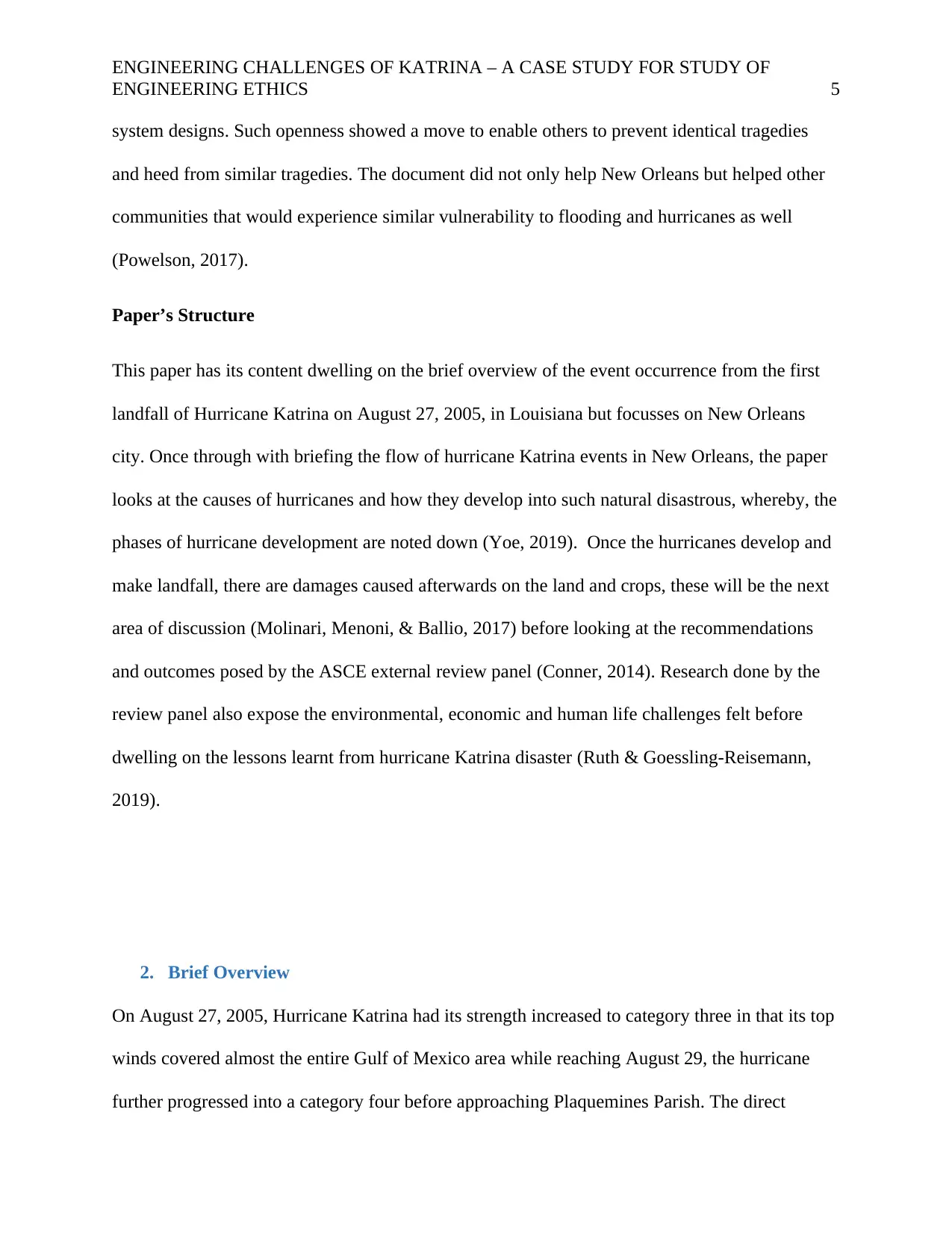
ENGINEERING CHALLENGES OF KATRINA – A CASE STUDY FOR STUDY OF
ENGINEERING ETHICS 5
system designs. Such openness showed a move to enable others to prevent identical tragedies
and heed from similar tragedies. The document did not only help New Orleans but helped other
communities that would experience similar vulnerability to flooding and hurricanes as well
(Powelson, 2017).
Paper’s Structure
This paper has its content dwelling on the brief overview of the event occurrence from the first
landfall of Hurricane Katrina on August 27, 2005, in Louisiana but focusses on New Orleans
city. Once through with briefing the flow of hurricane Katrina events in New Orleans, the paper
looks at the causes of hurricanes and how they develop into such natural disastrous, whereby, the
phases of hurricane development are noted down (Yoe, 2019). Once the hurricanes develop and
make landfall, there are damages caused afterwards on the land and crops, these will be the next
area of discussion (Molinari, Menoni, & Ballio, 2017) before looking at the recommendations
and outcomes posed by the ASCE external review panel (Conner, 2014). Research done by the
review panel also expose the environmental, economic and human life challenges felt before
dwelling on the lessons learnt from hurricane Katrina disaster (Ruth & Goessling-Reisemann,
2019).
2. Brief Overview
On August 27, 2005, Hurricane Katrina had its strength increased to category three in that its top
winds covered almost the entire Gulf of Mexico area while reaching August 29, the hurricane
further progressed into a category four before approaching Plaquemines Parish. The direct
ENGINEERING ETHICS 5
system designs. Such openness showed a move to enable others to prevent identical tragedies
and heed from similar tragedies. The document did not only help New Orleans but helped other
communities that would experience similar vulnerability to flooding and hurricanes as well
(Powelson, 2017).
Paper’s Structure
This paper has its content dwelling on the brief overview of the event occurrence from the first
landfall of Hurricane Katrina on August 27, 2005, in Louisiana but focusses on New Orleans
city. Once through with briefing the flow of hurricane Katrina events in New Orleans, the paper
looks at the causes of hurricanes and how they develop into such natural disastrous, whereby, the
phases of hurricane development are noted down (Yoe, 2019). Once the hurricanes develop and
make landfall, there are damages caused afterwards on the land and crops, these will be the next
area of discussion (Molinari, Menoni, & Ballio, 2017) before looking at the recommendations
and outcomes posed by the ASCE external review panel (Conner, 2014). Research done by the
review panel also expose the environmental, economic and human life challenges felt before
dwelling on the lessons learnt from hurricane Katrina disaster (Ruth & Goessling-Reisemann,
2019).
2. Brief Overview
On August 27, 2005, Hurricane Katrina had its strength increased to category three in that its top
winds covered almost the entire Gulf of Mexico area while reaching August 29, the hurricane
further progressed into a category four before approaching Plaquemines Parish. The direct
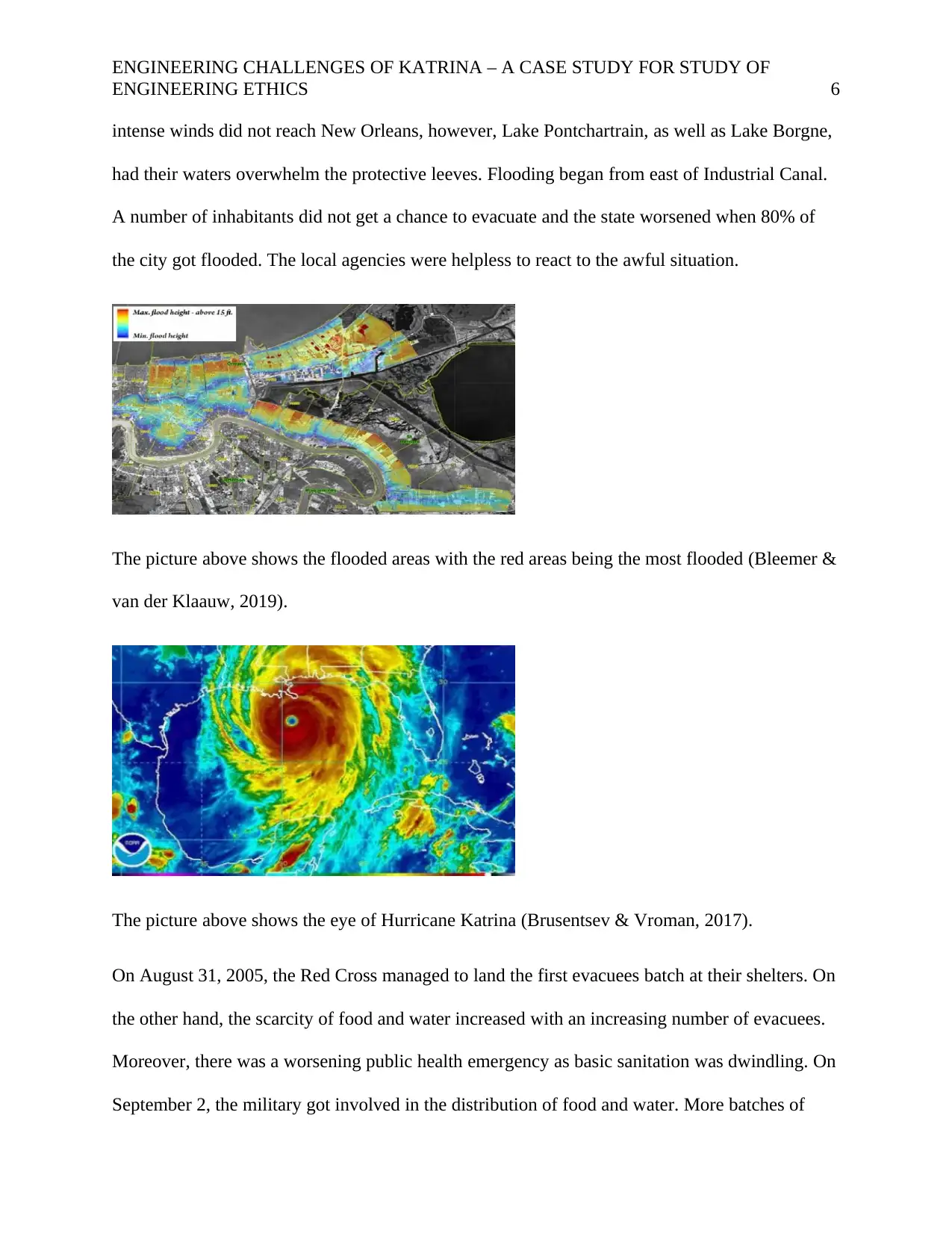
ENGINEERING CHALLENGES OF KATRINA – A CASE STUDY FOR STUDY OF
ENGINEERING ETHICS 6
intense winds did not reach New Orleans, however, Lake Pontchartrain, as well as Lake Borgne,
had their waters overwhelm the protective leeves. Flooding began from east of Industrial Canal.
A number of inhabitants did not get a chance to evacuate and the state worsened when 80% of
the city got flooded. The local agencies were helpless to react to the awful situation.
The picture above shows the flooded areas with the red areas being the most flooded (Bleemer &
van der Klaauw, 2019).
The picture above shows the eye of Hurricane Katrina (Brusentsev & Vroman, 2017).
On August 31, 2005, the Red Cross managed to land the first evacuees batch at their shelters. On
the other hand, the scarcity of food and water increased with an increasing number of evacuees.
Moreover, there was a worsening public health emergency as basic sanitation was dwindling. On
September 2, the military got involved in the distribution of food and water. More batches of
ENGINEERING ETHICS 6
intense winds did not reach New Orleans, however, Lake Pontchartrain, as well as Lake Borgne,
had their waters overwhelm the protective leeves. Flooding began from east of Industrial Canal.
A number of inhabitants did not get a chance to evacuate and the state worsened when 80% of
the city got flooded. The local agencies were helpless to react to the awful situation.
The picture above shows the flooded areas with the red areas being the most flooded (Bleemer &
van der Klaauw, 2019).
The picture above shows the eye of Hurricane Katrina (Brusentsev & Vroman, 2017).
On August 31, 2005, the Red Cross managed to land the first evacuees batch at their shelters. On
the other hand, the scarcity of food and water increased with an increasing number of evacuees.
Moreover, there was a worsening public health emergency as basic sanitation was dwindling. On
September 2, the military got involved in the distribution of food and water. More batches of
⊘ This is a preview!⊘
Do you want full access?
Subscribe today to unlock all pages.

Trusted by 1+ million students worldwide
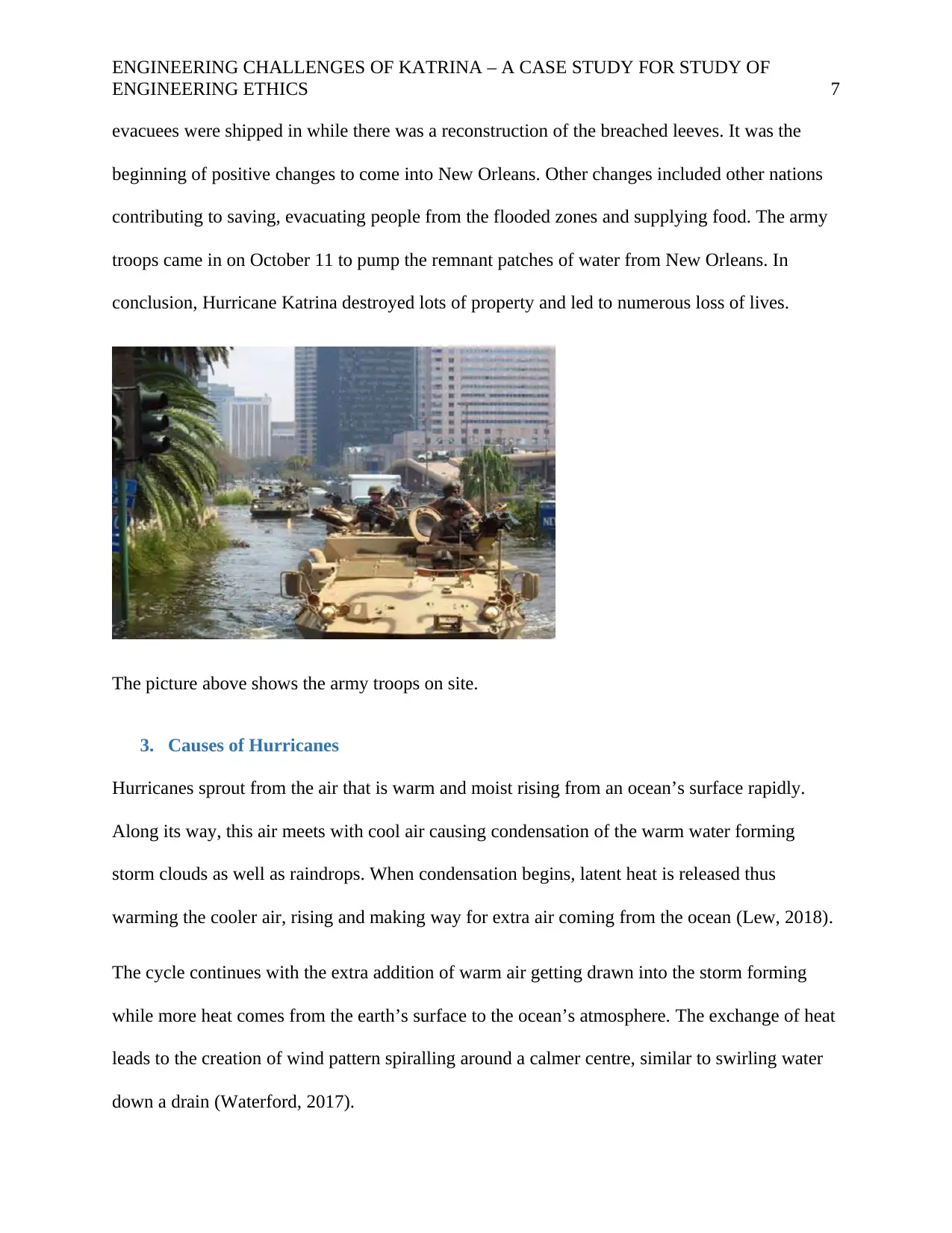
ENGINEERING CHALLENGES OF KATRINA – A CASE STUDY FOR STUDY OF
ENGINEERING ETHICS 7
evacuees were shipped in while there was a reconstruction of the breached leeves. It was the
beginning of positive changes to come into New Orleans. Other changes included other nations
contributing to saving, evacuating people from the flooded zones and supplying food. The army
troops came in on October 11 to pump the remnant patches of water from New Orleans. In
conclusion, Hurricane Katrina destroyed lots of property and led to numerous loss of lives.
The picture above shows the army troops on site.
3. Causes of Hurricanes
Hurricanes sprout from the air that is warm and moist rising from an ocean’s surface rapidly.
Along its way, this air meets with cool air causing condensation of the warm water forming
storm clouds as well as raindrops. When condensation begins, latent heat is released thus
warming the cooler air, rising and making way for extra air coming from the ocean (Lew, 2018).
The cycle continues with the extra addition of warm air getting drawn into the storm forming
while more heat comes from the earth’s surface to the ocean’s atmosphere. The exchange of heat
leads to the creation of wind pattern spiralling around a calmer centre, similar to swirling water
down a drain (Waterford, 2017).
ENGINEERING ETHICS 7
evacuees were shipped in while there was a reconstruction of the breached leeves. It was the
beginning of positive changes to come into New Orleans. Other changes included other nations
contributing to saving, evacuating people from the flooded zones and supplying food. The army
troops came in on October 11 to pump the remnant patches of water from New Orleans. In
conclusion, Hurricane Katrina destroyed lots of property and led to numerous loss of lives.
The picture above shows the army troops on site.
3. Causes of Hurricanes
Hurricanes sprout from the air that is warm and moist rising from an ocean’s surface rapidly.
Along its way, this air meets with cool air causing condensation of the warm water forming
storm clouds as well as raindrops. When condensation begins, latent heat is released thus
warming the cooler air, rising and making way for extra air coming from the ocean (Lew, 2018).
The cycle continues with the extra addition of warm air getting drawn into the storm forming
while more heat comes from the earth’s surface to the ocean’s atmosphere. The exchange of heat
leads to the creation of wind pattern spiralling around a calmer centre, similar to swirling water
down a drain (Waterford, 2017).
Paraphrase This Document
Need a fresh take? Get an instant paraphrase of this document with our AI Paraphraser
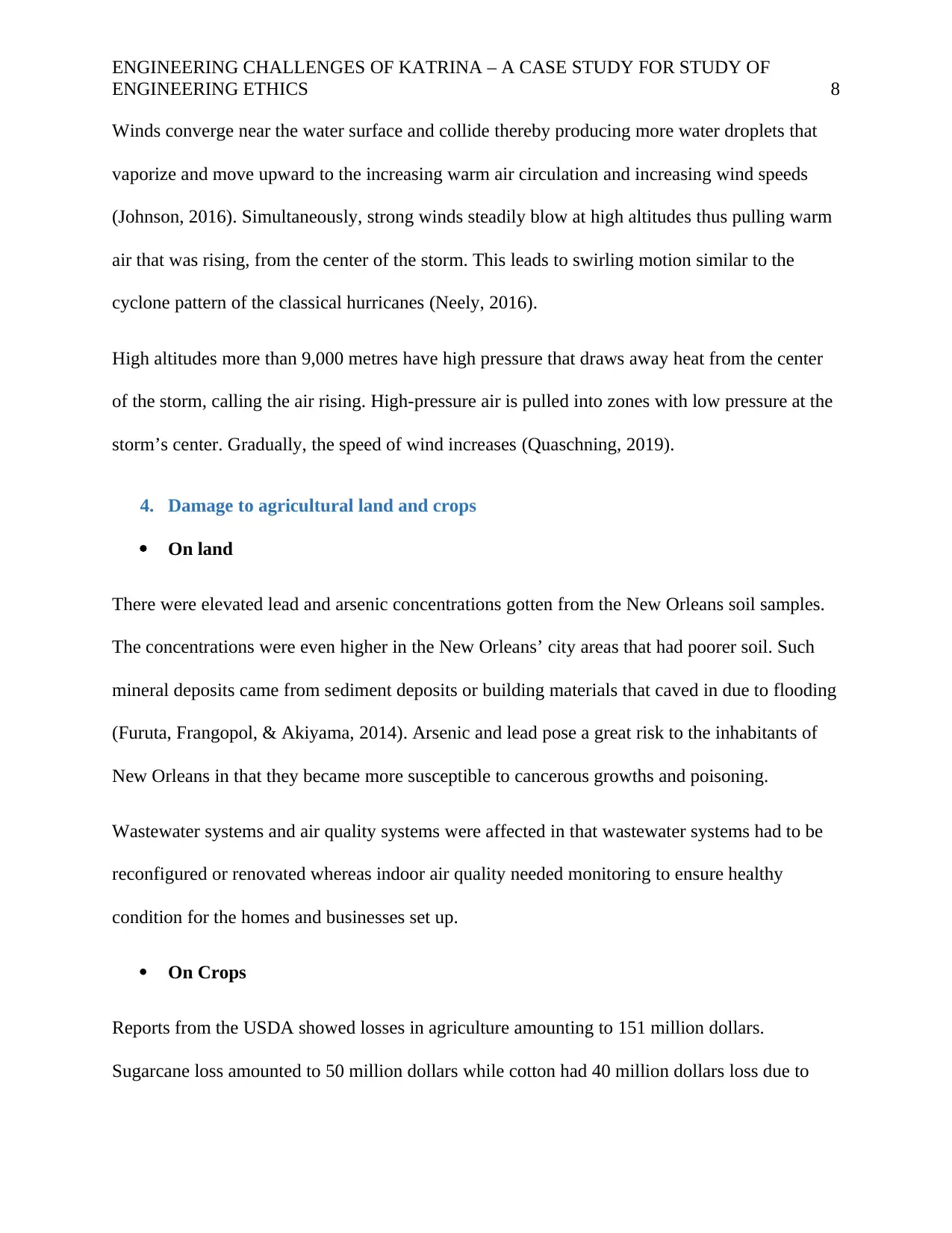
ENGINEERING CHALLENGES OF KATRINA – A CASE STUDY FOR STUDY OF
ENGINEERING ETHICS 8
Winds converge near the water surface and collide thereby producing more water droplets that
vaporize and move upward to the increasing warm air circulation and increasing wind speeds
(Johnson, 2016). Simultaneously, strong winds steadily blow at high altitudes thus pulling warm
air that was rising, from the center of the storm. This leads to swirling motion similar to the
cyclone pattern of the classical hurricanes (Neely, 2016).
High altitudes more than 9,000 metres have high pressure that draws away heat from the center
of the storm, calling the air rising. High-pressure air is pulled into zones with low pressure at the
storm’s center. Gradually, the speed of wind increases (Quaschning, 2019).
4. Damage to agricultural land and crops
On land
There were elevated lead and arsenic concentrations gotten from the New Orleans soil samples.
The concentrations were even higher in the New Orleans’ city areas that had poorer soil. Such
mineral deposits came from sediment deposits or building materials that caved in due to flooding
(Furuta, Frangopol, & Akiyama, 2014). Arsenic and lead pose a great risk to the inhabitants of
New Orleans in that they became more susceptible to cancerous growths and poisoning.
Wastewater systems and air quality systems were affected in that wastewater systems had to be
reconfigured or renovated whereas indoor air quality needed monitoring to ensure healthy
condition for the homes and businesses set up.
On Crops
Reports from the USDA showed losses in agriculture amounting to 151 million dollars.
Sugarcane loss amounted to 50 million dollars while cotton had 40 million dollars loss due to
ENGINEERING ETHICS 8
Winds converge near the water surface and collide thereby producing more water droplets that
vaporize and move upward to the increasing warm air circulation and increasing wind speeds
(Johnson, 2016). Simultaneously, strong winds steadily blow at high altitudes thus pulling warm
air that was rising, from the center of the storm. This leads to swirling motion similar to the
cyclone pattern of the classical hurricanes (Neely, 2016).
High altitudes more than 9,000 metres have high pressure that draws away heat from the center
of the storm, calling the air rising. High-pressure air is pulled into zones with low pressure at the
storm’s center. Gradually, the speed of wind increases (Quaschning, 2019).
4. Damage to agricultural land and crops
On land
There were elevated lead and arsenic concentrations gotten from the New Orleans soil samples.
The concentrations were even higher in the New Orleans’ city areas that had poorer soil. Such
mineral deposits came from sediment deposits or building materials that caved in due to flooding
(Furuta, Frangopol, & Akiyama, 2014). Arsenic and lead pose a great risk to the inhabitants of
New Orleans in that they became more susceptible to cancerous growths and poisoning.
Wastewater systems and air quality systems were affected in that wastewater systems had to be
reconfigured or renovated whereas indoor air quality needed monitoring to ensure healthy
condition for the homes and businesses set up.
On Crops
Reports from the USDA showed losses in agriculture amounting to 151 million dollars.
Sugarcane loss amounted to 50 million dollars while cotton had 40 million dollars loss due to
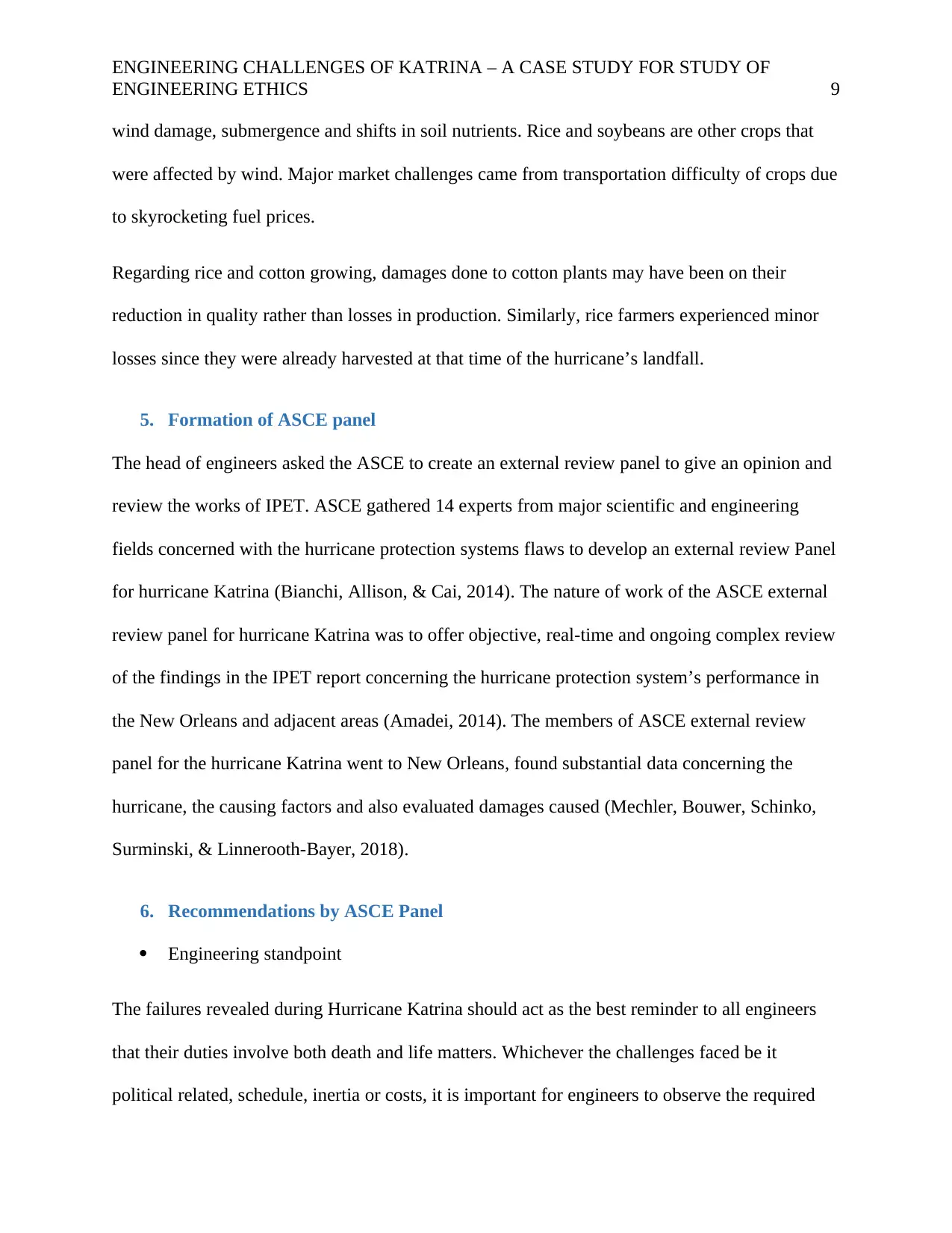
ENGINEERING CHALLENGES OF KATRINA – A CASE STUDY FOR STUDY OF
ENGINEERING ETHICS 9
wind damage, submergence and shifts in soil nutrients. Rice and soybeans are other crops that
were affected by wind. Major market challenges came from transportation difficulty of crops due
to skyrocketing fuel prices.
Regarding rice and cotton growing, damages done to cotton plants may have been on their
reduction in quality rather than losses in production. Similarly, rice farmers experienced minor
losses since they were already harvested at that time of the hurricane’s landfall.
5. Formation of ASCE panel
The head of engineers asked the ASCE to create an external review panel to give an opinion and
review the works of IPET. ASCE gathered 14 experts from major scientific and engineering
fields concerned with the hurricane protection systems flaws to develop an external review Panel
for hurricane Katrina (Bianchi, Allison, & Cai, 2014). The nature of work of the ASCE external
review panel for hurricane Katrina was to offer objective, real-time and ongoing complex review
of the findings in the IPET report concerning the hurricane protection system’s performance in
the New Orleans and adjacent areas (Amadei, 2014). The members of ASCE external review
panel for the hurricane Katrina went to New Orleans, found substantial data concerning the
hurricane, the causing factors and also evaluated damages caused (Mechler, Bouwer, Schinko,
Surminski, & Linnerooth-Bayer, 2018).
6. Recommendations by ASCE Panel
Engineering standpoint
The failures revealed during Hurricane Katrina should act as the best reminder to all engineers
that their duties involve both death and life matters. Whichever the challenges faced be it
political related, schedule, inertia or costs, it is important for engineers to observe the required
ENGINEERING ETHICS 9
wind damage, submergence and shifts in soil nutrients. Rice and soybeans are other crops that
were affected by wind. Major market challenges came from transportation difficulty of crops due
to skyrocketing fuel prices.
Regarding rice and cotton growing, damages done to cotton plants may have been on their
reduction in quality rather than losses in production. Similarly, rice farmers experienced minor
losses since they were already harvested at that time of the hurricane’s landfall.
5. Formation of ASCE panel
The head of engineers asked the ASCE to create an external review panel to give an opinion and
review the works of IPET. ASCE gathered 14 experts from major scientific and engineering
fields concerned with the hurricane protection systems flaws to develop an external review Panel
for hurricane Katrina (Bianchi, Allison, & Cai, 2014). The nature of work of the ASCE external
review panel for hurricane Katrina was to offer objective, real-time and ongoing complex review
of the findings in the IPET report concerning the hurricane protection system’s performance in
the New Orleans and adjacent areas (Amadei, 2014). The members of ASCE external review
panel for the hurricane Katrina went to New Orleans, found substantial data concerning the
hurricane, the causing factors and also evaluated damages caused (Mechler, Bouwer, Schinko,
Surminski, & Linnerooth-Bayer, 2018).
6. Recommendations by ASCE Panel
Engineering standpoint
The failures revealed during Hurricane Katrina should act as the best reminder to all engineers
that their duties involve both death and life matters. Whichever the challenges faced be it
political related, schedule, inertia or costs, it is important for engineers to observe the required
⊘ This is a preview!⊘
Do you want full access?
Subscribe today to unlock all pages.

Trusted by 1+ million students worldwide
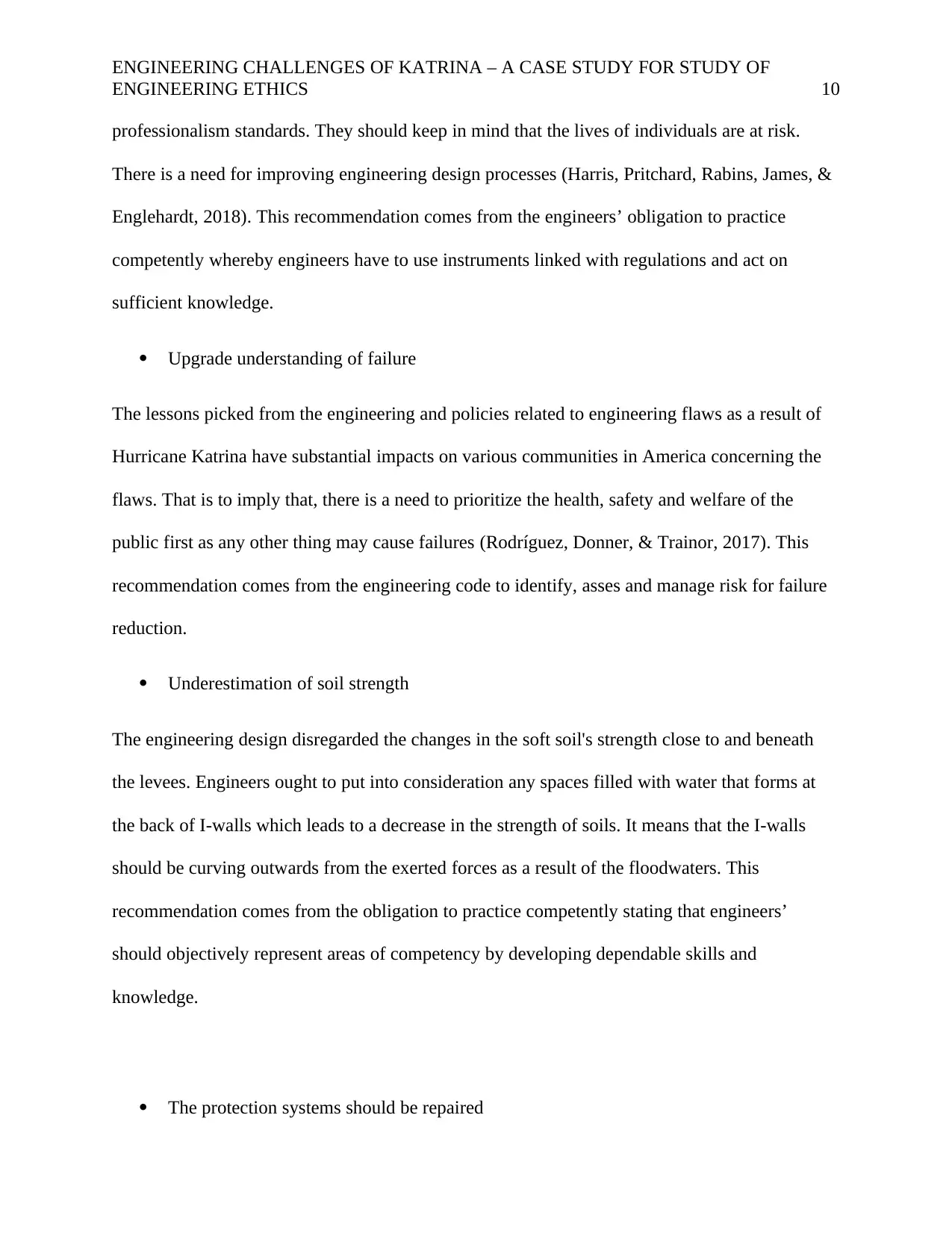
ENGINEERING CHALLENGES OF KATRINA – A CASE STUDY FOR STUDY OF
ENGINEERING ETHICS 10
professionalism standards. They should keep in mind that the lives of individuals are at risk.
There is a need for improving engineering design processes (Harris, Pritchard, Rabins, James, &
Englehardt, 2018). This recommendation comes from the engineers’ obligation to practice
competently whereby engineers have to use instruments linked with regulations and act on
sufficient knowledge.
Upgrade understanding of failure
The lessons picked from the engineering and policies related to engineering flaws as a result of
Hurricane Katrina have substantial impacts on various communities in America concerning the
flaws. That is to imply that, there is a need to prioritize the health, safety and welfare of the
public first as any other thing may cause failures (Rodríguez, Donner, & Trainor, 2017). This
recommendation comes from the engineering code to identify, asses and manage risk for failure
reduction.
Underestimation of soil strength
The engineering design disregarded the changes in the soft soil's strength close to and beneath
the levees. Engineers ought to put into consideration any spaces filled with water that forms at
the back of I-walls which leads to a decrease in the strength of soils. It means that the I-walls
should be curving outwards from the exerted forces as a result of the floodwaters. This
recommendation comes from the obligation to practice competently stating that engineers’
should objectively represent areas of competency by developing dependable skills and
knowledge.
The protection systems should be repaired
ENGINEERING ETHICS 10
professionalism standards. They should keep in mind that the lives of individuals are at risk.
There is a need for improving engineering design processes (Harris, Pritchard, Rabins, James, &
Englehardt, 2018). This recommendation comes from the engineers’ obligation to practice
competently whereby engineers have to use instruments linked with regulations and act on
sufficient knowledge.
Upgrade understanding of failure
The lessons picked from the engineering and policies related to engineering flaws as a result of
Hurricane Katrina have substantial impacts on various communities in America concerning the
flaws. That is to imply that, there is a need to prioritize the health, safety and welfare of the
public first as any other thing may cause failures (Rodríguez, Donner, & Trainor, 2017). This
recommendation comes from the engineering code to identify, asses and manage risk for failure
reduction.
Underestimation of soil strength
The engineering design disregarded the changes in the soft soil's strength close to and beneath
the levees. Engineers ought to put into consideration any spaces filled with water that forms at
the back of I-walls which leads to a decrease in the strength of soils. It means that the I-walls
should be curving outwards from the exerted forces as a result of the floodwaters. This
recommendation comes from the obligation to practice competently stating that engineers’
should objectively represent areas of competency by developing dependable skills and
knowledge.
The protection systems should be repaired
Paraphrase This Document
Need a fresh take? Get an instant paraphrase of this document with our AI Paraphraser
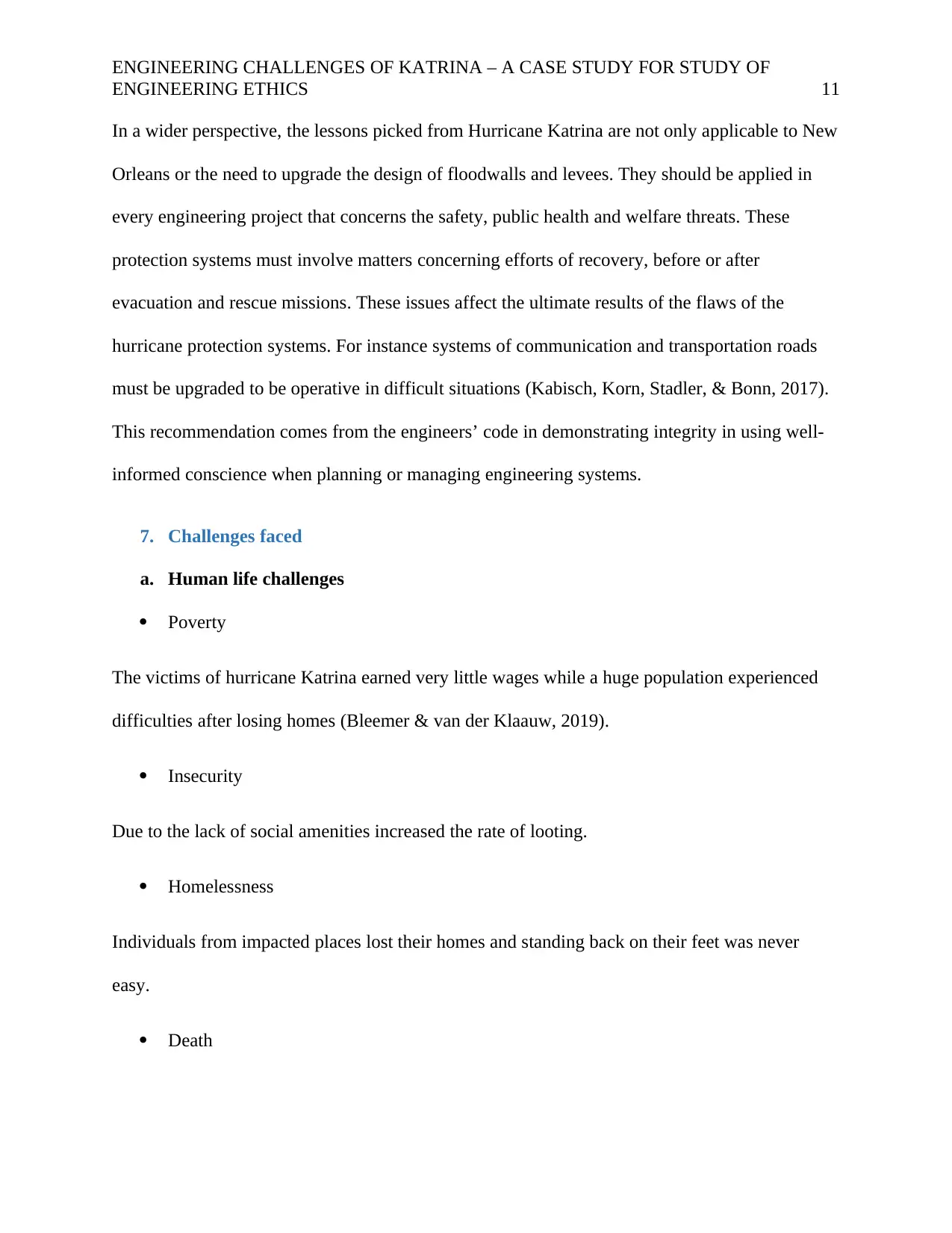
ENGINEERING CHALLENGES OF KATRINA – A CASE STUDY FOR STUDY OF
ENGINEERING ETHICS 11
In a wider perspective, the lessons picked from Hurricane Katrina are not only applicable to New
Orleans or the need to upgrade the design of floodwalls and levees. They should be applied in
every engineering project that concerns the safety, public health and welfare threats. These
protection systems must involve matters concerning efforts of recovery, before or after
evacuation and rescue missions. These issues affect the ultimate results of the flaws of the
hurricane protection systems. For instance systems of communication and transportation roads
must be upgraded to be operative in difficult situations (Kabisch, Korn, Stadler, & Bonn, 2017).
This recommendation comes from the engineers’ code in demonstrating integrity in using well-
informed conscience when planning or managing engineering systems.
7. Challenges faced
a. Human life challenges
Poverty
The victims of hurricane Katrina earned very little wages while a huge population experienced
difficulties after losing homes (Bleemer & van der Klaauw, 2019).
Insecurity
Due to the lack of social amenities increased the rate of looting.
Homelessness
Individuals from impacted places lost their homes and standing back on their feet was never
easy.
Death
ENGINEERING ETHICS 11
In a wider perspective, the lessons picked from Hurricane Katrina are not only applicable to New
Orleans or the need to upgrade the design of floodwalls and levees. They should be applied in
every engineering project that concerns the safety, public health and welfare threats. These
protection systems must involve matters concerning efforts of recovery, before or after
evacuation and rescue missions. These issues affect the ultimate results of the flaws of the
hurricane protection systems. For instance systems of communication and transportation roads
must be upgraded to be operative in difficult situations (Kabisch, Korn, Stadler, & Bonn, 2017).
This recommendation comes from the engineers’ code in demonstrating integrity in using well-
informed conscience when planning or managing engineering systems.
7. Challenges faced
a. Human life challenges
Poverty
The victims of hurricane Katrina earned very little wages while a huge population experienced
difficulties after losing homes (Bleemer & van der Klaauw, 2019).
Insecurity
Due to the lack of social amenities increased the rate of looting.
Homelessness
Individuals from impacted places lost their homes and standing back on their feet was never
easy.
Death
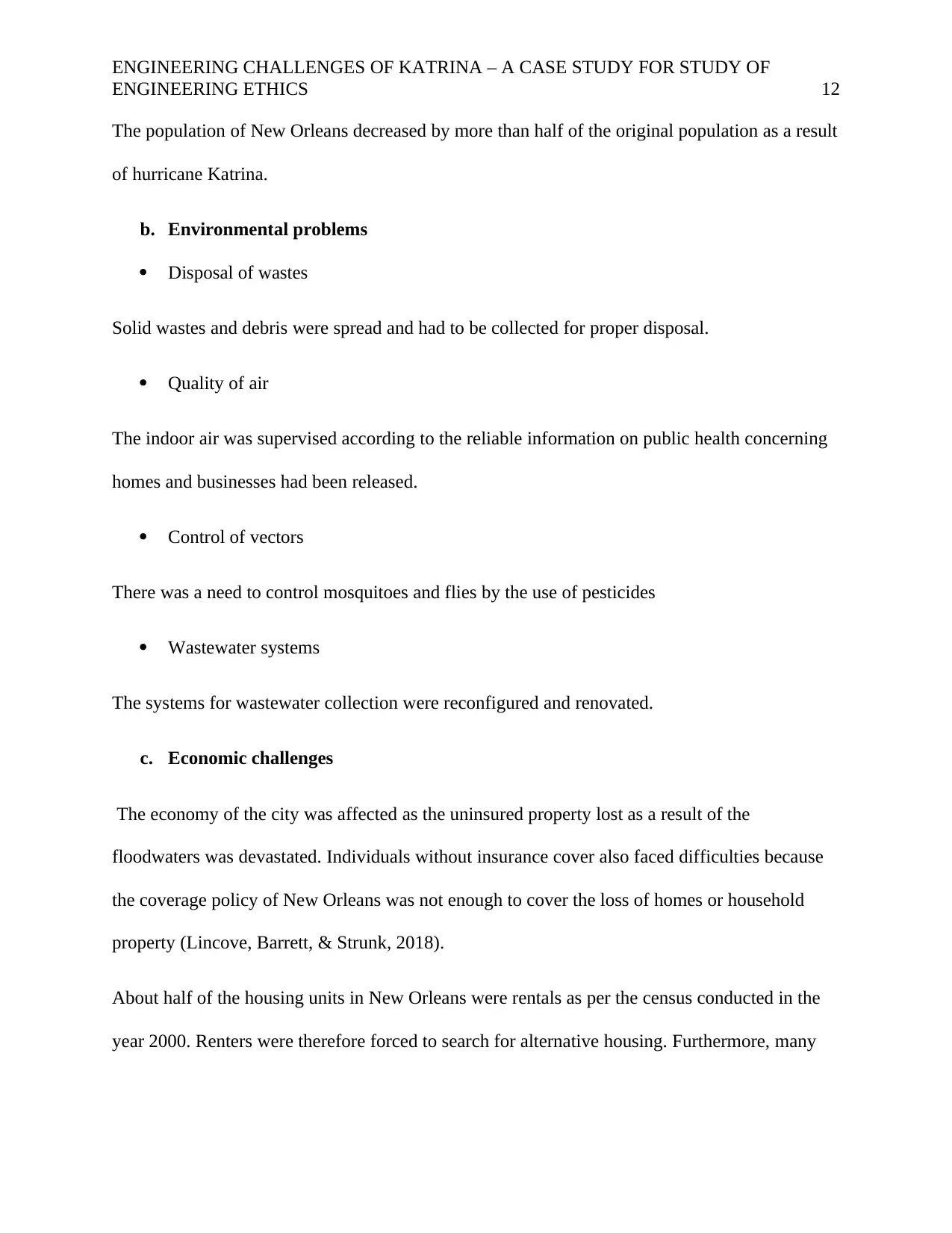
ENGINEERING CHALLENGES OF KATRINA – A CASE STUDY FOR STUDY OF
ENGINEERING ETHICS 12
The population of New Orleans decreased by more than half of the original population as a result
of hurricane Katrina.
b. Environmental problems
Disposal of wastes
Solid wastes and debris were spread and had to be collected for proper disposal.
Quality of air
The indoor air was supervised according to the reliable information on public health concerning
homes and businesses had been released.
Control of vectors
There was a need to control mosquitoes and flies by the use of pesticides
Wastewater systems
The systems for wastewater collection were reconfigured and renovated.
c. Economic challenges
The economy of the city was affected as the uninsured property lost as a result of the
floodwaters was devastated. Individuals without insurance cover also faced difficulties because
the coverage policy of New Orleans was not enough to cover the loss of homes or household
property (Lincove, Barrett, & Strunk, 2018).
About half of the housing units in New Orleans were rentals as per the census conducted in the
year 2000. Renters were therefore forced to search for alternative housing. Furthermore, many
ENGINEERING ETHICS 12
The population of New Orleans decreased by more than half of the original population as a result
of hurricane Katrina.
b. Environmental problems
Disposal of wastes
Solid wastes and debris were spread and had to be collected for proper disposal.
Quality of air
The indoor air was supervised according to the reliable information on public health concerning
homes and businesses had been released.
Control of vectors
There was a need to control mosquitoes and flies by the use of pesticides
Wastewater systems
The systems for wastewater collection were reconfigured and renovated.
c. Economic challenges
The economy of the city was affected as the uninsured property lost as a result of the
floodwaters was devastated. Individuals without insurance cover also faced difficulties because
the coverage policy of New Orleans was not enough to cover the loss of homes or household
property (Lincove, Barrett, & Strunk, 2018).
About half of the housing units in New Orleans were rentals as per the census conducted in the
year 2000. Renters were therefore forced to search for alternative housing. Furthermore, many
⊘ This is a preview!⊘
Do you want full access?
Subscribe today to unlock all pages.

Trusted by 1+ million students worldwide
1 out of 17
Related Documents
Your All-in-One AI-Powered Toolkit for Academic Success.
+13062052269
info@desklib.com
Available 24*7 on WhatsApp / Email
![[object Object]](/_next/static/media/star-bottom.7253800d.svg)
Unlock your academic potential
Copyright © 2020–2025 A2Z Services. All Rights Reserved. Developed and managed by ZUCOL.




